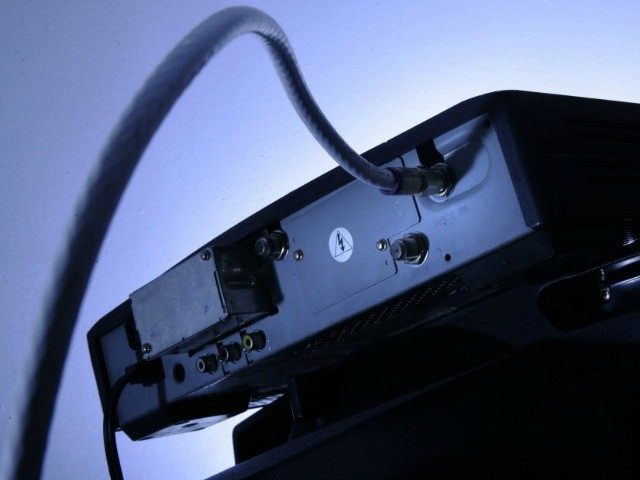The Wall Street Journal recently published a strange piece called “Why Cable TV Beats the Internet, For Now.” Despite pay-TV losing 1.4 million customers last year, it seems the WSJ is device-challenged and unwilling to embrace the obvious future dominance of Internet streaming media. And the war to discount your cost for pay-TV is heating up.
Geoffrey A. Fowler of the WSJ’s Person Tech section describes himself as a “tech columnist and someone who watches enough TV to own a Snuggie.” He acknowledges that cord-cutting allows cheaper choices than pay-TV, but strangely he worries that “Internet TV means juggling gadgets.”
The prospect of consumers ditching cable by “cutting the cord” has been a looming threat to the pay-TV industry for years. Unwilling to attack their own bloated cost structure, cable companies have tried to maximize the bill with pricey new monthly services for subscribers. But in the fourth quarter of 2014, pay-TV providers had an aggregate add of just 101,000 subscribers. DirecTV and Dish Network satellite services added 86,000, plus telephone companies added 185,000. But cable operators lost 170,000 subscribers–a 2.2 percent decline.
Variety calculated that the damage to cable was even more stunning, considering that new household formation last year was the fastest growth in 10 years, according to the U.S. Census Bureau. That means 1.4 million American households either canceled pay-TV over the trailing 12 months, or never subscribed.
Craig Moffett who follows the industry from his Wall Street perch at MoffettNathanson Research, calculated that since 2010, the industry has cumulatively lost or failed to sign up 3.8 million households. He recently warned, “A year from now, the fourth quarter may well be viewed as the calm before the storm.”
Moffett’s analysis reveals the monthly cost for the video portion for all U.S. cable bills averages $80 to $90 a month, including pay-per-view movies and premium channels. Broadband Internet adds up to $50 on top of that in a bundle, for a $130 monthly total.
Given that cable subscriptions could soon be falling like bungee jumping without a cord, Moffett believes Comcast’s proposed cable consolidation with Time Warner Cable now has at best only a 60-40 percent chance of winning government approval. He worries about “the hostility of the regulatory climate in Washington” after the recent FCC Net Neutrality regulations that blatantly favored Silicon Valley apps over cable operators.
The media networks are actively planning to help the pay-TV bundle disintegrate by moving to the Internet. Showtime and Viacom’s Nickelodeon already have on-demand (OTT) video plans. HBO plans to launch a standalone and over-the-top subscription service for $15 this year. CBS debuted an “SVOD” service that allows on-demand consumption of its flagship network’s TV programs, thousands of episodes from current programs, classic series in its library, and content from its local-TV stations.
Perhaps the most attractive opportunity for cord cutters is Dish Network’s launch of its $20 per month Sling TV service with about a dozen channels–including ESPN. Together with video-on-demand (VOD) services like Netflix, Hulu, and Amazon Prime and Instant Video, alternatives to cable TV are already significantly less expensive.
Yet Fowler states that “after reviewing pretty much every available Internet TV service, streaming box and smart TV, I’ve yet to find a replacement that covers all the TV bases while costing less.” He recommends “shaving down” your cable-and-broadband subscription, then supplementing it with streaming services such as Hulu, Amazon and Netflix until this change “all shakes out.”
Fowler does acknowledge that later in 2015, the Internet may become a serious alternative to cable. He offers a rave reviews for the new pioneering service that streams big networks, called PlayStation Vue service, for those who have a Sony Play Station 4. But given that the total worldwide console sales only hit 20 million on March 1, this is not going to be a meaningful option for the 320 million residents of the United States.
My suggestion–if you are not ready for cord cutting–is to renegotiate the rate Comcast, Time Warner, AT&T or Verizon offer for their bundled service by asking for the “loyalty program.” Since cable companies are paid on the size of their subscriber base by content providers, most cable companies are so desperate to hold individual subscriptions they will cut your monthly bundle rate by 25%, without a new contract.
I have personally called the “loyalty program” at Comcast twice this year and re-negotiated down the monthly cost for my cable video package, high-speed broadband and Internet home phone service.
Warning: they may transfer you around several times, perhaps hoping that you become frustrated and hang up. But if you tough-out the wait game, you will be able to convince their “retention specialist” you need a better price.
I suggest you comment about how much you love Comcast [or substitute your provider], but must switch to Dish [substitute any satellite provider], because you cannot afford the monthly subscription price. The retention specialist will miraculously find a plan that is almost exactly what you already have, except at about a 25 percent discount.
Warning: Getting a discount on your cable bill will put a big smile on your face.

COMMENTS
Please let us know if you're having issues with commenting.